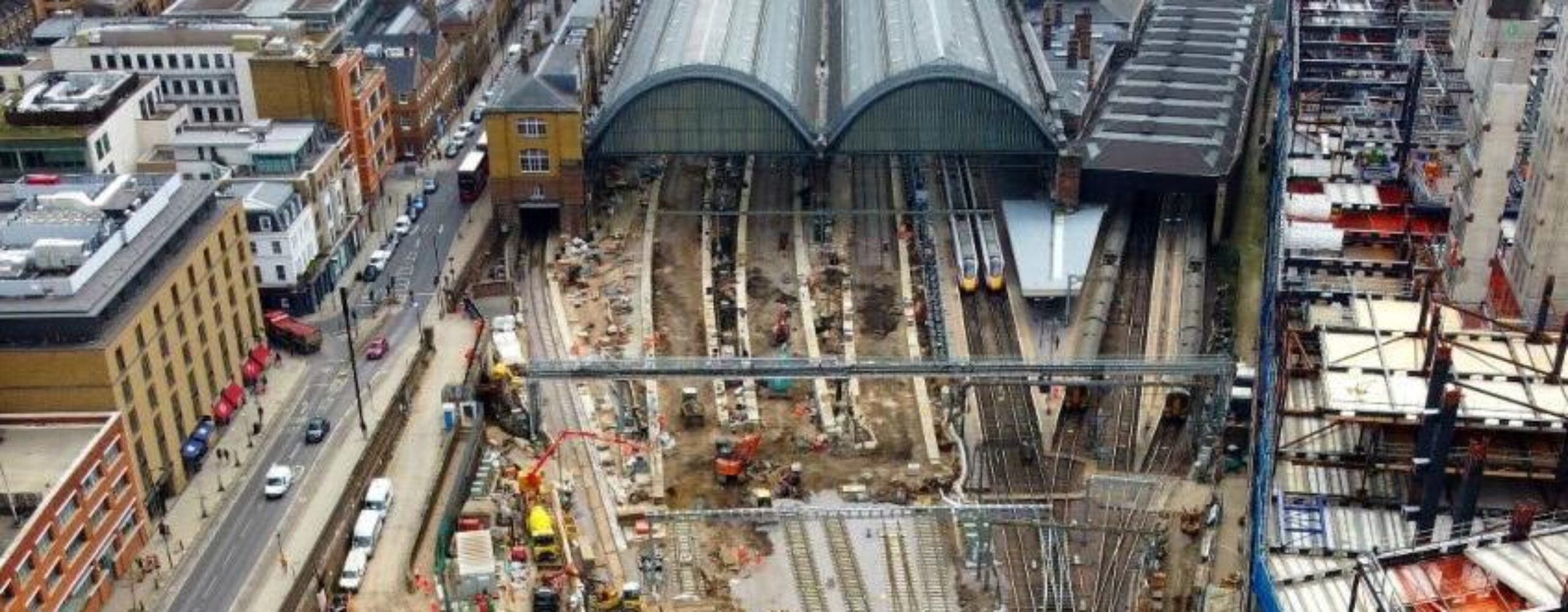A key element of one of the highest profile projects in a generation. Although delivered as a Tier 2 subcontractor, due to the collaborative nature of the delivery we were heavily involved in design, engineering, and delivery albeit the design was managed by our client.
Project Overview
The overall project scope simplified the layout of tracks leading to this iconic station, improving reliability by making it easier for trains to arrive and leave. The reopening of the third Gasworks Tunnel, which was closed in the 1970s, added two extra tracks on the approach to the station.
The core renewals took place over a 101 day partial closure of the station in early 2021. The first weekend saw a complete closure to split the station in two, this allowed works to commence from 0-6 while 7-11 remained operational. When all works were completed on 0-6 the closure was reversed to continue the works on 7-11 with trains using the new platforms at 0-6.
Our Role
Pod-Trak delivered two key elements of the project – the demolition and reconstruction of all platforms 0-11 to suit the new track alignment direct for Network Rail and the removal of all existing Overhead Line Equipment (OLE) and replacing with new for Morgan Sindall. Scope & Methodology The OLE works were designed and planned to suit the overall staging within the 101 day partial closure with the key constraints being the interface with other contractors and disciplines on site along with challenging site logistics. Other than Stages 1, 3 & 5 which were weekend closures of the entire station, all works during Stages 2 & 4 were delivered in a live and operational station environment under ALO and managed by Pod-Trak POS.
This approach required extremely accurate planning with all ALO, POS and Lift Plans reviewed daily alongside the construction programme and altered as required with key staff based on site. The project was heavily focused on passengers first and this was always a top priority through each of the
stages – successful on time delivery of each stage was testament to this.
Design
Pod-Trak conducted a full construction assessment on the design issued and a design validation survey was undertaken on site to identify issues in advance and provide an opportunity for the design team to address in advance of the works. As-built records were compiled and recorded in the ITPs and complied to the Project AMP requirements to assist the Network Rail Asset Management Team to take over the maintenance following entry into service. During the assessment several items were identified that avoided construction issues during the construction stages. Due to the complexity of the design, our CRE requested that a designer be always available during the build, this proved to be a valuable exercise as unforeseen clashes could be addressed in real time to avoid delays.
Pre works
A material build-up team were based at Murphy’s Yard to manage and build-up all free issue materials required for the works including the logistics planning of getting everything to site as required by each of the main stages.
Stage 1
The Fast lines from Kings Cross Buffer stops to Copenhagen Tunnels were decommissioned including the recovery of 10nr wire runs, modification of 3nr wire runs that were critical for the future stage works, recovery of redundant cantilevers, registration assemblies, associated SPS, removal of redundant structures and bonding disconnections. This stage also saw the fast and slow lines being electrically separated from each other.
Stage 2
Complete reconstruction of the Fast lines with the OLE constructed to align with the newly installed track layout. All main steel was installed and dressed with SPS followed by 17nr wire runs with all associated registration, panning and switching. The Fast Lines Permanent Earth Section (PES) at
Holloway was removed. Tensorex Units were installed along with 1nr AEW in the Copenhagen Tunnel and all required traction bonding. Works carried out during this stage were under ALO with trains still operational into Platforms 7-11.
Stage 3
The Fast Lines were successfully commissioned and entered service allowing Platforms 0-6 to become operational again. The Slow Lines (Platforms 7-11) were decommissioned with 6nr wire runs being recovered and shortening of 2nr wire runs. Redundant AEW, registration assemblies, SPS, structures
and switches were recovered and removed from site.
Stage 4
Complete reconstruction of the Slow lines with the OLE constructed to align with the newly installed track layout. All main steel was installed including anchor portal and dressed with SPS followed by 6nr wire runs from Kings Cross buffers to Belle Isle with all associated registration, panning and switching. 2nr wire runs were extended to form an insulated overlap and closed air gap protection. Works carried out during this stage were under ALO with trains still operational into Platforms 0-6.
Stage 5
The final stage of this complex project saw the commissioning of the Slow Lines into Platforms 7-11. Works consisted of the installation, registration & handback of 2nr wire runs in Belle Isle 019 and 1nr wire run in the throat. All section proving was successfully completed and the entire station safely reopened for full operational use.
Delivering Expertise
During the first key phase and working around the clock, Platforms 0-6 were demolished and OLE removed while working alongside many other disciplines such as track and signalling. Working in a small area with many interfaces required detailed planning and integration – all while Platforms
7-11 remained open to passenger services. The complexity of the works and sheer volume of programme interdependencies meant that every subcontractor including Pod-Trak had to achieve daily milestones and report on progress every 4 hours. Even the smallest delay to works had the potential to
disrupt numerous key activities.
An excellent standard of collaboration across the board meant that by the halfway point the new Platforms 0-6 were successfully handed over on time including all new OLE to power the East Coast Azuma Trains. While the works on 7-11 were similar in nature, they presented new logistical challenges as the access strategy was different.
A complete logistics plan was agreed between all stakeholders to ensure that works could progress while using a third-party access point at the new Google building. Regular meetings were held with Network Rail, Morgan Sindall, and all other parties to understand the complex possessions/isolations and the changing logistics especially where 3rd party access was required at the Google Building. Detailed readiness reviews were held prior to each mobilisation stage attended by all the key management, engineering, and delivery staff.
The replacement of the end of life OLE will result in a more reliable service as new and more reliable equipment will reduce defects and delays, bringing huge benefits to all those that use the station and putting the passenger first. All electrical testing, section proving, and commissioning was successfully delivered by our Engineering Team.
Over the 101 days a huge volume of work was successfully delivered on time by Pod-Trak on one of the highest profile projects delivered by Network Rail in a generation, not just within the Eastern Region but Nationally. To be involved in such a project and to self-deliver key works that will be visible at the station for years to come was a fantastic opportunity for a business that is an SME and directly employing our specialist OLE resource along with introducing apprentices into the industry.
Health, Safety & Welfare
As with all the works undertaken by Pod-Trak we undertook a meticulous readiness review with the project team involved including a peer review. We utilised our OP11 Job Delivery start up process to ensure that a RACI was completed, with all actions assigned to an owner and tracked to completion.
We scheduled and participated in regular progress meetings with Network Rail and Morgan Sindall to ensure all were kept informed of any key milestones, actions or issues arising. The Project Team ensured the following documentation was produced and kept up to date throughout the project for each
stage;
- SPS Installation in Belle Isle Kings Cross Station Remodelling Completed
- Rosters for all the works to manage fatigue and confirm staff competence for key stages.
- Safety validated hour-by-hour programme.
- Possession Contingency Plans (jointly signed off by Pod-Trak, Morgan Sindall & Network Rail.
- Work Package Plan and Task Briefs.
- ALO Plans, POS Packs and Lift Plans.
- Safety briefings and Toolbox Talks.
All safety submissions from the site teams including Good Calls, Close Calls, Take 5s and Site Inspections were recorded on our app and issued on a regular basis to Morgan Sindall. Regular Site visits from Directors and HSQE demonstrated our commitment to a safe and efficient project delivery.
“Great work again yesterday and last night, really well done. You all set off where you left last week. Hope everything goes well tonight with Section proving but from me I personally want to say thanks for everything so far. It is just so impressive, to me it’s a real project award winner.” Mark Bell, Programme Manager – Network Rail

